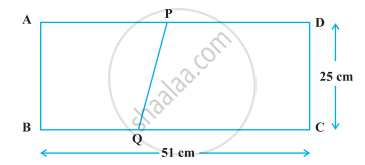Advertisements
Advertisements
प्रश्न
The point A divides the join of P (−5, 1) and Q(3, 5) in the ratio k:1. Find the two values of k for which the area of ΔABC where B is (1, 5) and C(7, −2) is equal to 2 units.
उत्तर
GIVEN: point A divides the line segment joining P (−5, 1) and Q (3, −5) in the ratio k: 1
Coordinates of point B (1, 5) and C (7, −2)
TO FIND: The value of k
PROOF: point A divides the line segment joining P (−5, 1) and Q (3, −5) in the ratio k: 1
So the coordinates of A are `(3k+1)/(k+1),(5k+1)/(k+1)`
We know area of triangle formed by three points (x1,y1)(x2,y2) and (x3,y3)s given by
Δ `= 1/2([x1y2+x2y3+x3y1)-(x2y1+x3y2+x1y3)]`
Now Area of ΔABC= 2 sq units.
Taking three points A `[(3k+1)/(k+1),(5k+1)/(k+1)]`, B (1, 5) and C (7, −2)
`2=1/2[{((3k-5)/(k+1))5-2+7((5k+1)/(k+1))}-((5k+1)/(k+1)) +35-2((3k-5)/(k-1))]`
`2=1/2[{((15k-25)/(k+1))-2+((35k+7)/(k+1))}-((5k-1)/(k+1))+35-((6k-10)/(k+1))]`
`2=1/2[((15k-25-2k+35k+7)/(k+1))-((5k+1+35k-6k+10)/(k+1))]`
`2=1/2[((48-20-(34k+46))/(k+1))]`
`2=1/2[((48k-20)-(34k+46))/(k+1))]`
`2=1/2[((14k-66)/(k+1))]`
`2=[((7k-33)/(k-1))]`
`+-=((7k-33)/(k+1))]`
⇒ 7k -33= ±2(k+1)
⇒ 7k -33= 2(k+1), 7k-33= -2(k+1)
⇒7k -33=2k +2, 7k+2k= +33- 2
⇒ 7k -2k=33 +2, 7k+2k =+33- 2
⇒ 5k =35,9k=31
`⇒k =35/5,k=31/9 `
⇒ k=7,k=`31/9`
Hence k=7 or `31/9`
APPEARS IN
संबंधित प्रश्न
The coordinates of A, B, C are (6, 3), (–3, 5) and (4, – 2) respectively and P is any point (x, y). Show that the ratio of the areas of triangle PBC and ABC is
median of a triangle divides it into two triangles of equal areas. Verify this result for ΔABC whose vertices are A (4, - 6), B (3, - 2) and C (5, 2).
Find the area of a triangle with vertices at the point given in the following:
(1, 0), (6, 0), (4, 3)
Find the missing value:
| Base | Height | Area of triangle |
| 15 cm | ______ | 87 cm2 |
If the coordinates of the mid-points of the sides of a triangle are (1, 1), (2, —3) and (3, 4), find the vertices of the triangle.
prove that the points A (7, 10), B(-2, 5) and C(3, -4) are the vertices of an isosceles right triangle.
If the points A (x, y), B (3, 6) and C (−3, 4) are collinear, show that x − 3y + 15 = 0.
If A, B, C are the angles of a triangle, then ∆ = `|(sin^2"A", cot"A", 1),(sin^2"B", cot"B", 1),(sin^2"C", cot"C", 1)|` = ______.
The area of a triangle with vertices (a, b + c), (b, c + a) and (c, a + b) is ______.
The dimensions of a rectangle ABCD are 51 cm × 25 cm. A trapezium PQCD with its parallel sides QC and PD in the ratio 9 : 8, is cut off from the rectangle as shown in the following figure. If the area of the trapezium PQCD is `5/6` th part of the area of the rectangle, find the lengths QC and PD.

